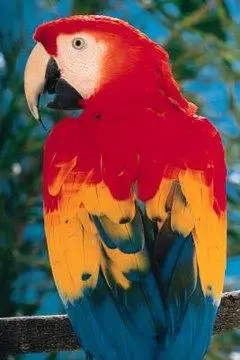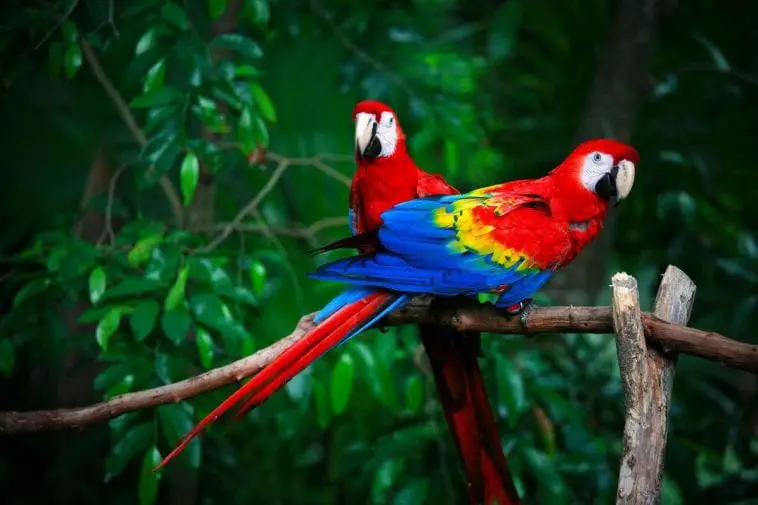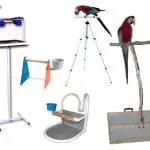Have you tried to look into your bird’s enclosure as you were passing by, and you suddenly noticed that it is gone? Then you, as the pet owner, try to hold down that feeling of nervousness, as you frantically look the cage with your two eyes. Then you noticed that it was just inside its cage, right where you looked in that direction a while ago, and you saw nothing. It is called camouflage.
Camouflage is one of the coloring features of a parrot. It is a compound science, and this seems to be occasionally dismissing logic. The true feature that makes the parrot stick out in the animal world is its coloring, and it even the same with the one that helps keep it concealed from the eyes of a hungry predator of parrots.
The parrots and many kinds of other animals use a pattern as well as a different color as a way of camouflage. The intent of the bold patterns and vivid colors of the parrot are to distort the outline of the animal’s body. In the eyes of the predators, it follows the outline of what they believe to the body of their incoming prey; the color or simply says the pattern change will make the eye becomes sharp to the left and right to disrupt the image.
Most of the bright color parrots are inclined to have a green, yellow and blue under their sides that blend into the setting of the dim lighting of the forest from below and depend on their pattern and their color disruption to be safe from above.
Good-to-Know Facts About Parrots Coloring Features
In reality, all about the parrot’s coloring is totally hoax. Most of the vibrant colored feathers do not literally consist of what they appear to be its predominant color at all, but it is instead the product of the trick to the lighting. Some of the colors can absorb light, while some others can reflect it, and this makes the use of the effect that is called the Tyndall effect.
What Is the Tyndall Effect?
Tyndall effect is an illusion that makes using light, with the same illusion that assembles the sky to see as blue if the truth is not. Parrots also have to develop to host the coloring that made it safe in the bird’s natural habitat. most of the parrots are vividly in regard to its color, and some are seen to be multi-colored. Most parrots show little or no sexual dimorphism when it comes to the parrot’s visual spectrum.
It stated that most number is a tree occupant, and it makes sense that the majority of the parrots are green, or largely green. That parrot that is color green is produced by the assistance of a yellow pigment. This is laid down in the exterior layer of the bird’s feathers and interconnect with the Tyndall blue to develop the illusion of the color green. If the yellow pigment is falsely take away, the feathers become blue color.
If you are going to take one of the back feathers of your blue, the gold macaw just holds it up to a variety of angles to a direct sun lighting; then, you will notice that at definite angles, it is emphatically brown and it is not to be blue. The color green, blue, and purple feathers are actually consisting of none of these kinds of colors at all.
The number of red and yellow psittacines in a different bird can partially show the bird’s overall color. the blue mutation of the birds is with the full absence of the red and yellow psittacine. another element of the birds that are helping to make the physical appearance of the blue is the light scattering.
Advantages and Disadvantages of a Bright Color for the Parrot

Most parrot species have a bright color. The scientist has been convincing that the bird’s bright colors are the outcome of a sexual selection. The color of the feathers is developed by the use of pigmentation, the light refraction in opposition to the bird’s feathers structure, or the combination of the two. It is considered that the male birds are usually more colorful than the female birds, but in the most numbers of the parrot’s species, they are both sexes are vivid.
The Parrot’s Color Imagination
Video Source: Youtube
The birds are commonly had an excellent when it comes to a color vision. It is said to be that the parrots have a better color vision than humans do, some parrots can even see the ultraviolet rays or the color that is undetectable by just a naked human eye. They can also see the differences in the feather colors that are also comparably undetectable to a human. The parrots can also identify other kinds of birds, and their sex depends on their color.
How the Color of the Parrot Influence the Courtship and Mating
The parrot is commonly chosen as a mate that has a bright and vibrant color when breeding season. The meaning of a brighter color indicates that the bird is healthy. The majority of colorful males have a higher sperm count, and the most colorful females will develop a larger and healthier clutches of a young bird. The birds that are sick or infested with a parasite usually have evenly dull feathers.
Bright Colors As Used to Send Messages
The parrot commonly uses its bright color to transmit messages to its fellow birds. The female Eclectus parrots utilize its bright and red color to notify enemies that is away from its nesting area. Parrots may also use its color to set up territory boundaries and to manifest their supremacy over other some kind of parrots: the brighter birds are considered as generally stronger while others will be leery in challenging them. The colors can also be blazed as a caution to other kinds of parrots in the colony that is about to approach dangers.
How the Color of the Parrot May Affects Young Feeding
The parrots may use color as well as a pattern as recognition when they feed their young baby. The parrot eggs can hatch on alternate days, so that the baby birds ages, as well as the size, can become different.
The older juveniles are in need of more food than the smaller or younger parrots. The parents that are usually using their brightness that around the edges of young babies allow them to open their mouths to feed them. Also, the brightness of their head feathers specify are who most in need of nourishment.
How the Color of the Parrot May Affects to Camouflage Ability
The parrot’s bright colors can usually make them be more significant to their predators. But still, the most number of the wild parrots usually live in a rainforest surrounding, and they are been camouflage when they are among the glowing colored flowers, berries as well as fruits of their habitat.
The bright-green parrot birds can easily vanish among bright-green vegetation. Because of its colorful surroundings, they may live in, the parrot’s brilliant colors are not usually a disadvantage when they wish to hide.
Conclusion
Since you have learned that parrots use their coloring features for different purposes, you are more confident to take good care of your parrot pet. They use their colors to hide if they sense danger or a predator is nearby. It’s also one way to make their young ones recognize mother parrot when feeding their babies. Also, the colors of a parrot play a crucial role in mating.



